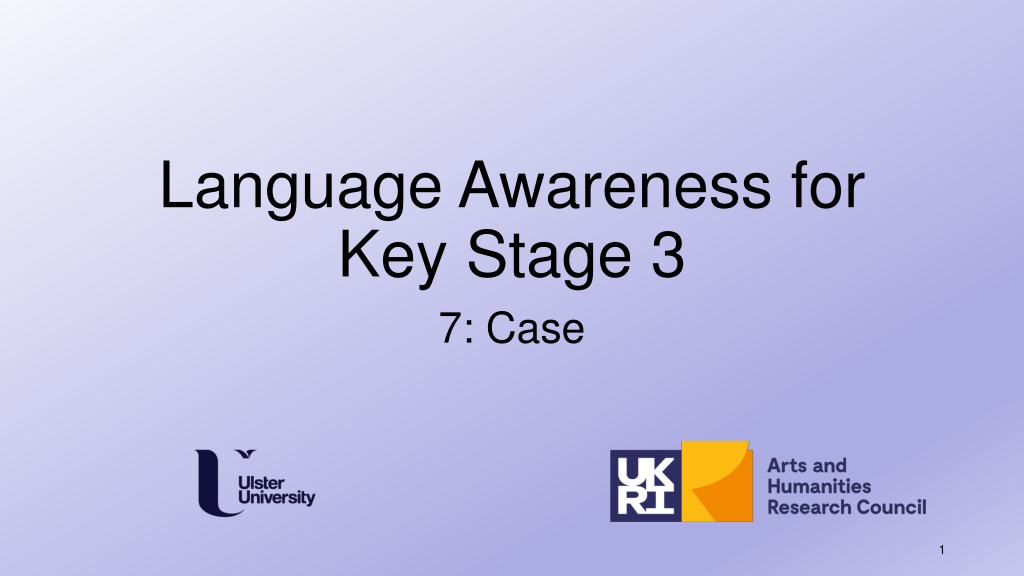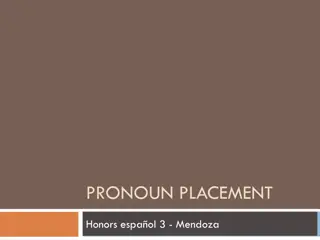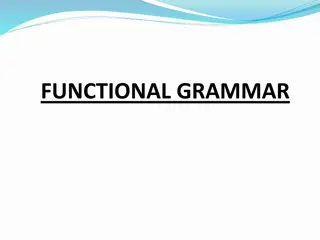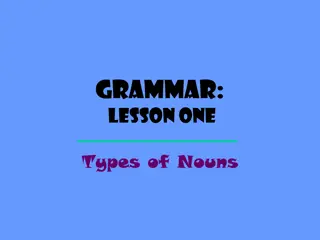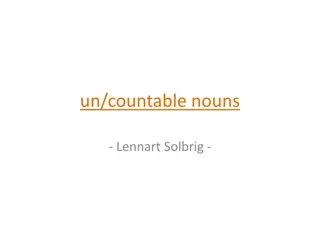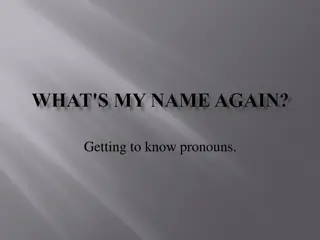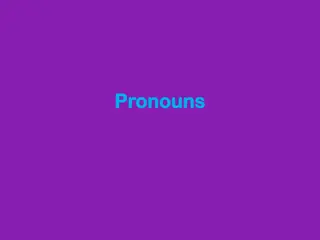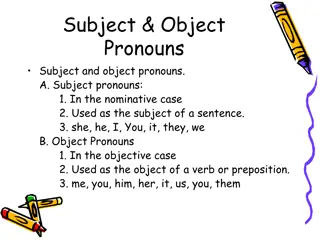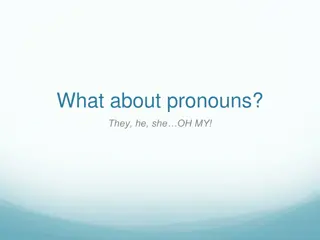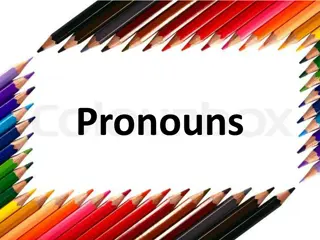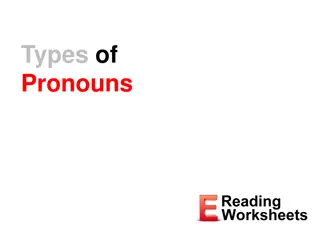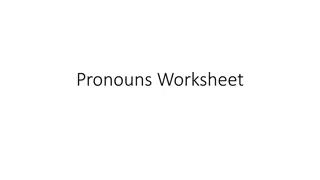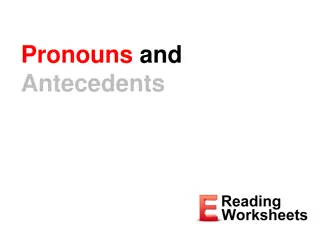Nouns and Pronouns: The Concept of Case
Dive into the intricacies of noun and pronoun cases in language, exploring how they impact sentence structure and meaning. Discover the nuances between nominative and accusative cases, and explore examples to enhance your language awareness.
Download Presentation

Please find below an Image/Link to download the presentation.
The content on the website is provided AS IS for your information and personal use only. It may not be sold, licensed, or shared on other websites without obtaining consent from the author.If you encounter any issues during the download, it is possible that the publisher has removed the file from their server.
You are allowed to download the files provided on this website for personal or commercial use, subject to the condition that they are used lawfully. All files are the property of their respective owners.
The content on the website is provided AS IS for your information and personal use only. It may not be sold, licensed, or shared on other websites without obtaining consent from the author.
E N D
Presentation Transcript
Language Awareness for Key Stage 3 7: Case 1
Roadmap Today we will look at another property of nouns and pronouns: case We will see how case works in English, and how case is sometimes visible and sometimes not Then we can go on to see how case works in other languages Some languages have no cases, but others have a lot of them Some of these cases are more fundamental than others 2
What Is Case? Case is a property of nouns and pronouns related to their role in a sentence (i.e. as a subject, an object or something else). 3
What Is Case? Some cases are already familiar to you from English 1. I saw them 2. They saw me The forms in red, I and they, are for subjects The forms in blue, me and them, are for objects 4
What Is Case? Case relates to the structure of the sentence, not necessarily to the meaning 3. I saw them 4. I was seen by them In (3), I refers to the person seeing, while in (4), I refers to the person being seen However, I is the subject in both sentences (even though its relation to seeing is different) This means that I appears in the same case in both sentences 5
What Is Case? The case used for subjects (I, they) is called the nominative case The case used for objects (me, them) is called the accusative case In English, most pronouns have separate forms for these two cases However, there can be a difference in case even without a difference in form 6
What Is Case? 5. Mary saw me 6. She saw me 7. I saw Mary 8. I saw her We can say that Mary in (5) is nominative, because it can only be replaced by she Likewise, Mary in (7) is accusative, because it can only be replaced by her However, there is only a single form Mary for both cases 7
Activity Try to make a list of all the words in English with separate nominative and accusative forms Which pronouns have the same form in both cases? 8
Solution 9
Solution Two Forms we us One Form it it Nominative Accusative I he him she her they them who whom (thee) (thou) you you what what which which me As you can see, there are some pronouns without separate nominative and accusative forms 9. You saw it 10.It saw you 10
What Cases Are There? So far we ve looked at the nominative and accusative cases However, these are not the only possible cases Many languages also have a genitive case The genitive case can indicate the relation of one noun or pronoun to another noun or pronoun 11
What Cases Are There? One of the main uses of the genitive case is to indicate possession You can see how the genitive case works by looking at possessive forms in English 11.This is John s book 12.This book is John s The forms in green indicate the relation of John to the book 12
What Cases Are There? There are many languages that use a genitive case to indicate possession 13. Hansens Buch (German) 14. leabhar She in (Irish) 15. Jonno honga (Japanese) 16. Jana ksi ka (Polish) 17. kniga Ivana (Russian) 13
What Cases Are There? There are certain differences between English possessives and the genitive case found in some other languages For example, in Latin the genitive can express possession 18.Hic est Iohannis liber This is John s book But it can also be used with partitive meaning (relating a part to a whole) 19.aquae sextarius water s pint a pint of water 14
What Cases Are There? Another common case is the dative case The dative case is often used for the indirect object of a verb As such, it frequently refers to a person who receives something 15
What Cases Are There? Direct object (accusative) I see her 20. Je la vois German 21. Ich sehe sie Polish 22. Widz j Indirect object (dative) I give her a book 23. Je lui donne un livre 24. Ich gebe ihr ein Buch 25. Daj jej ksi k French Polish does not use words for I or a The sentences you see are literally See her and Notice how in French, the pronouns ( her ) come before the verb ( see , give ) Give her book 16
What Cases Are There? Different languages do not always use cases in the same way With the verb meaning help , German and Polish use the dative case Help can be seen as something that you receive However, French uses the accusative case Help can also be seen as something done to you 26.Je l aide (French) 27.Ich helfe ihr (German) 28.Pomog jej (Polish) 17
What Does Case Do? In a language like English, where case is not shown on most words, we can use word order to tell subjects and objects apart Languages with more case marking can be more flexible about word order 18
What Does Case Do? 29. Iohannes dedit Mariae librum 41. Mariae dedit Iohannes librum 30. Iohannes dedit librum Mariae 42. Mariae dedit librum Iohannes 31. Iohannes Mariae dedit librum 43. Mariae Iohannes dedit librum 32. Iohannes Mariae librum dedit 44. Mariae Iohannes librum dedit 33. Iohannes librum dedit Mariae 45. Mariae librum Iohannes dedit 34. Iohannes librum Mariae dedit 46. Mariae librum dedit Iohannes 35. Dedit Iohannes Mariae librum 47. Librum Iohannes dedit Mariae 36. Dedit Iohannes librum Mariae 48. Librum Iohannes Mariae dedit 37. Dedit Mariae Iohannes librum 49. Librum dedit Iohannes Mariae 38. Dedit Mariae librum Iohannes 50. Librum dedit Mariae Iohannes 39. Dedit librum Iohannes Mariae 51. Librum Mariae Iohannes dedit 40. Dedit librum Mariae Iohannes 52. Librum Mariae dedit Iohannes 19
Activity Some of you may know languages other than the ones we ve seen here What cases do these languages have? You can start by trying to translate some of the sentences that we ve seen (e.g. with see, give, help) Can you find any cases that we haven t seen yet? 20
Case in Different Languages We ve seen that different languages distinguish different cases For example, there are no separate dative forms in English, but there are in French, German, and Polish But exactly how much variation is there? 21
Case in Different Languages Chinese makes no case distinctions at all 53.W k n t men I see them 54.T men k n w They see me I and me are the same word, w They and them are the same word, t men As in English, you can use word order to tell which is the subject and which is the object 22
Case in Different Languages Finnish has as many as 15 cases! 23
Case in Different Languages Name Example Meaning Nominative he they Accusative heid t them Genitive heid n their Dative (Allative) heille to them Ablative heilt from them Adessive heill at them Illative heihin into them Elative heist out of them Inessive heiss within them Essive hein as them Abessive heitt without them Partitive heit of them Translative heiksi until them Instructive hein with them Comitative heineen along with them 24
Case in Different Languages As you can see from the table, many of these Finnish cases are translated into English using prepositions It s even possible to use prepositions as a different way of saying some of the things we ve seen in English 55.I took John s picture 56.I sent Mary the picture 57.I took a picture of John 58.I sent the picture to Mary 25
Case in Different Languages However, it isn t possible to express the meaning of the nominative or accusative case with a preposition We can t replace I or me with anything in the same way that we can replace John s with of John This may suggest to you that nominative and accusative are in some ways the most basic cases Many languages have special nominative and accusative case forms, but very few have special elative case forms 26
Case and Determiners In English, if you use a possessive form you can t use a determiner as well 59.the book 60.John s book 61.the John s book 27
Case and Determiners This is also true in some other languages, such as Irish 62.an leabhar the book 63.leabhar She in John s book However, there are also languages such as Greek, where you can use both 64.t I nnou bibl on the John s book 28
Case and Determiners You may remember from before that we called words like my and your determiners, because they appear in the same places as words like the and that However, these words can also be seen as case forms of pronouns, so that my has the same relationship to I as John s does to John These different ways of looking at the same words reflect different aspects of their meaning 29
Conclusion Case shows the role of nouns and pronouns within a sentence The nominative and accusative are for the subject and object The genitive case shows relationships such as possession Sometimes genitive forms can be used instead of determiners The dative case is for indirect objects (e.g. recipients) Some languages do not distinguish any of these cases, while others distinguish more than a dozen The information that case conveys can also be shown by word order or prepositions 30
